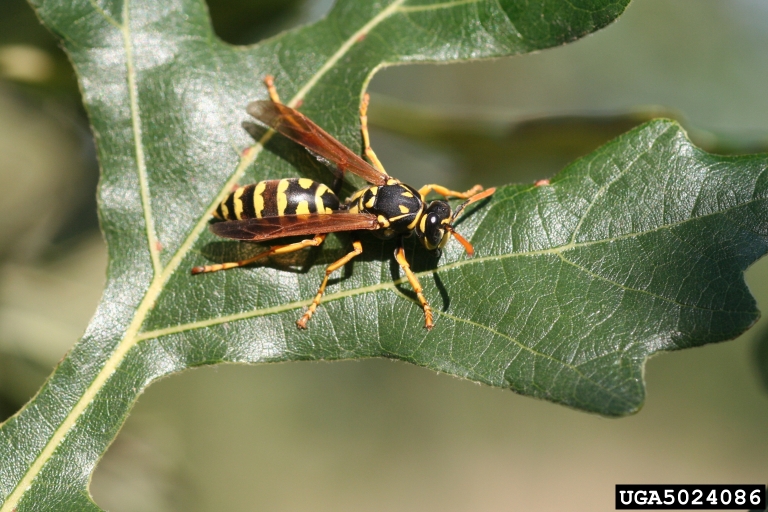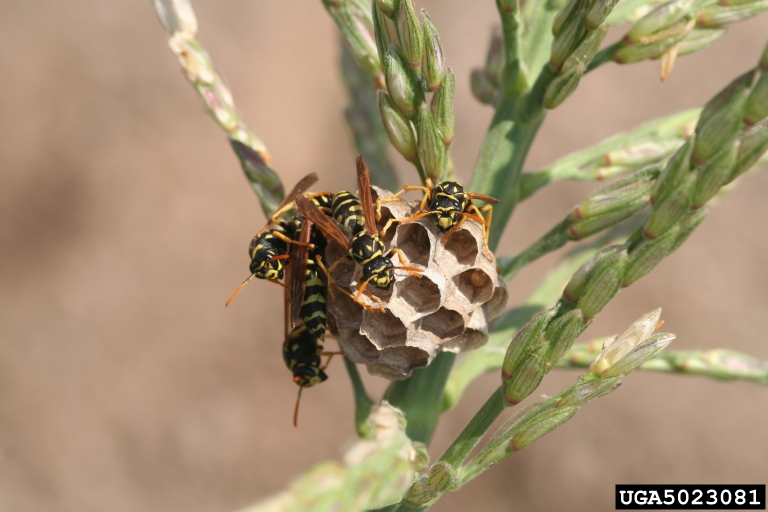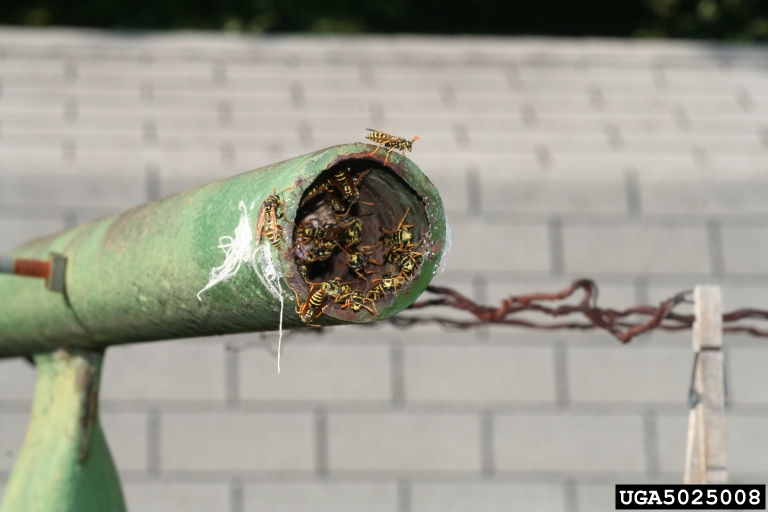 European Paper Wasps - July 31, 2013 Jeff Schalau, Agent, Agriculture & Natural Resources University of Arizona Cooperative Extension, Yavapai County Paper wasps and yellowjackets are beneficial insects. They feed on caterpillars and other insects that could damage crops and ornamental plants in your garden. They also feed on house fly and blow fly larva. Paper wasps and yellowjackets are social insects that become aggressive when their nests are approached or disturbed. This is typically when people and animals are stung. These stings are painful and can be life threatening to allergic individuals. Even so, these insects should be respected and tolerated under most conditions. The European paper wasp (Polistes dominula) is a relative newcomer that has become established in many areas of Arizona (it was recorded in Utah in 1995). It is generally black marked with yellow. Like other wasps, they are fairly slender-bodied insects with a distinct constriction of the body between the thorax and abdomen. The paper nests of this wasp are commonly observed in yards and gardens and the wasp is involved in stinging incidents. The nests can also be in sheds, under eaves, and other protected locations such as wood piles and dog houses. The European paper wasp is superficially similar to and commonly mistaken for various yellowjackets. A somewhat blunter, more compact body form distinguishes yellowjackets from the European paper wasp. Also, the long hind legs of paper wasps tend to trail below when the insects are in flight. Both have a painful sting, but yellowjackets usually nest in the ground making it more likely that humans inadvertently disturb their nests and get stung (often multiple times). The European paper wasp is a social insect that produces an annual colony in a paper nest. Individual colonies are established anew each spring. The overwintering stage are females (queens), only slightly larger than the wasps typically observed during summer. Female wasps that were fertilized the previous fall survive winter in protected sites. When they emerge from overwintering shelters, they may be seen on warm days as they seek sites to establish new nests. Earliest activity is sometimes seen in the first half of March. Nests are constructed of paper, produced from chewed wood fibers of weathered fences, porch decks and similar sites. Initially, a few hexagonal paper cells are formed and eggs are laid in the cells. Upon hatch, the wasp larvae are fed crushed insects, usually caterpillars, the overwintered queen discovers in foraging trips among nearby plants. When full grown, the larvae then seal over the cell and pupate. Development from egg to adult usually takes three to four weeks. The newly hatched wasps assist in colony activities of nest construction, foraging, and caring for young. The original queen increasingly remains restricted to the nest as new workers take over colony activities. The colony continues to grow and may contain several dozen individuals by the end of summer. A few of the wasps produced later in summer are males and increasing numbers of the females become sexually mature at that same time. Mating occurs and the mated females will seek shelter over winter and begin a new nest the following spring. When nests are not in a location where they are likely to be disturbed, it is usually best to leave them in place. The nests will be abandoned at the end of the season at which time they can be safely removed. When nests are in an area where they could interfere with human activity, livestock, or pets, they can be treated with over-the-counter pesticides and rendered harmless. A wide variety of “wasp and hornet” marketed products are effective. If nests are treated it is recommended to apply treatments in the evening or at night. At this time most of the wasps have returned to the nest so that they can be killed and, after dark, flying activities are greatly reduced. Do not shine a flashlight on the colony as the wasps will follow the light beam when disturbed. After the nest has been killed it should be removed and destroyed. This will eliminate larvae that were within capped cells during spraying. It is also recommended that after a nest is removed the area also be washed with a jet of water to eliminate colony odors. These practices can inhibit surviving wasps from attempting to reestablish a nest upon return. Photos and additional information are available on the web version of the column. Follow the Backyard Gardener on Twitter – use the link on the BYG website. If you have other gardening questions, call the Master Gardener help line in the Camp Verde office at 928-554-8999 Ext. 3 or e-mail us at cottonwoodmg@yahoo.com and be sure to include your name, address and phone number. Find past Backyard Gardener columns or provide feedback at the Backyard Gardener web site: http://cals.arizona.edu/yavapai/anr/hort/byg/. Additional Resources European Paper Wasp, Whitney Cranshaw, Colorado State University Extension Entomologist http://www.ext.colostate.edu/pubs/insect/05611.html Home Wasp Control, Diane Alston, Utah State University Extension Entomologist http://utahpests.usu.edu/htm/plant-pest-news/articleID=21902  European paper wasp on oak leaf (Whitney Cranshaw, Colorado State University, Bugwood.org).  European paper wasp nest on corn tassel (Whitney Cranshaw, Colorado State University, Bugwood.org).  European paper wasp nest in clothes line pole end (Whitney Cranshaw, Colorado State University, Bugwood.org). |